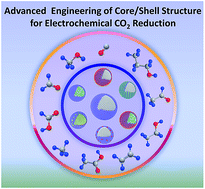Advanced engineering of core/shell nanostructures for electrochemical carbon dioxide reduction
Abstract
The electrochemical carbon dioxide reduction (CO2RR) into useful fuels and chemicals provides a promising avenue to relieve severe energy and environmental crises. Core/shell structures hold enormous potential for the CO2RR due to the strong synergistic effect and varied electronic modification, although they still suffer from inadequate efficiency and poor selectivity. Recent achievements reveal the advanced engineering of core/shell structures, including strain engineering (e.g., tensile or compressive strain), surface engineering (e.g. surface doping, surface defects, and surface reduction) and phase engineering (e.g., newly formed interfaces), for boosting the CO2RR activity and selectivity due to their powerful effect on modulating the surface environment, constructing more active sites and interfaces and optimizing conductivity. In this review, we focus on the advanced engineering of core/shell structures as a promising candidate for the CO2RR. First, the wet-chemical methods for achieving core/shell structures via one-step or multi-step pathways are elaborated. Then we illustrate the important role of these three strategies in optimizing the CO2RR performance: (1) strain engineering, (2) surface engineering and (3) phase engineering. Finally, we highlight the key issues that need to be resolved and provide an outlook that may be useful for guiding future development of this promising field.

- This article is part of the themed collection: Recent Review Articles


 Please wait while we load your content...
Please wait while we load your content...